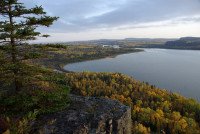Ontario Environmental Issues
As we close the books on 2015, the International Year of Soils, let’s look back at the events related to weather and water that impacted our cropping year.
The weather at planting was almost ideal. As we finished planting, we were looking for some rain but instead many areas were hit hard by a late May frost that killed off buds and shoots on grapes, along with apples and some soy fields. Some of these areas experienced nearly 80 per cent losses.
And when it did start to rain, it felt like it wouldn’t stop. Here in Guelph, we got nearly seven inches of rain and there was even more in areas to the southwest and in eastern Ontario. It was the wettest June that Windsor had seen in 75 years. But for most other areas, it wasn’t nearly as wet as the spring of 2010.
July brought with it nearly perfect growing conditions, even though we lagged in heat units and were concerned about the lack of warm nights that the corn likes so much.
Our fears of an early frost faded with a beautiful September that finished most crops off naturally. When can you remember attending Canada’s Outdoor Farm Show when all the show days were as nice as they were this year? And after some damp stretches in October, a warm November allowed us plenty of opportunity to harvest, and even time to clean the equipment.
This year’s weather has been good to most parts of Ontario, but our concerns about weather, water and nutrients never went away as some new issues emerged this year.
This year, the International Joint Commission on the Great Lakes challenged southwestern Ontario to reduce the amount of phosphorus lost into the Great Lakes by 40 per cent, with a keen focus on Lake Erie. This will be a tall order for agriculture as we do not yet understand all the pathways that phosphorus takes to enter the lake. We do know though that the majority of phosphorus runs off in the spring thaw and in major storm events, both of which are inevitable. Because we cannot control the weather, we will need to control our timing and placement of nutrients. Easier said than done.
In other water news, the Ministry of the Environment and Climate Change (MOECC) made an announcement on October 5th that they will be “enhancing the Permit to Take Water (PTTW) program to ensure water takings in Ontario are managed to the standards of the Great Lakes-St. Lawrence River Basin Sustainable Water Resources Agreement.” Even though these changes were not intended to deter agricultural uses, they may make it more difficult for farmers to get a PTTW in areas of high use or deemed higher risk.
Twenty-two source protection plans have been developed to date by Source Protection Committees. These plans cover 19 regions within the province and contain more than 12, 500 proposed policies designed to reduce or eliminate threats to sources of drinking water, and at a cost of more than $240 million dollars. The provincial auditor has pointed out that no plan has yet been established to fund the implementation of these source protection plans, many of which occur on farmland.
It should also be noted that there is no plan for funding the implementation of Bill 66, passed early this fall. Bill 66, better known as the Great Lakes Protection Act, governs activities in the Great Lakes Basin and will certainly extend to agricultural activities, though we aren’t yet sure what that will look like. Apparently, the provincial auditor is not impressed with OMAFRA’s policy to educate and inform farmers, but seems to think that agriculture needs to be regulated in aspects of our water and nutrient usage, without any seeming consideration for the costs of implementing such programs.
So you can see that there are many environmental issues that will continue into 2016 and likely well beyond. Please stay involved in your association’s efforts and with Farm & Food Care as we continue to engage stakeholders in discussion on environmental issues surrounding water and nutrient usage.










